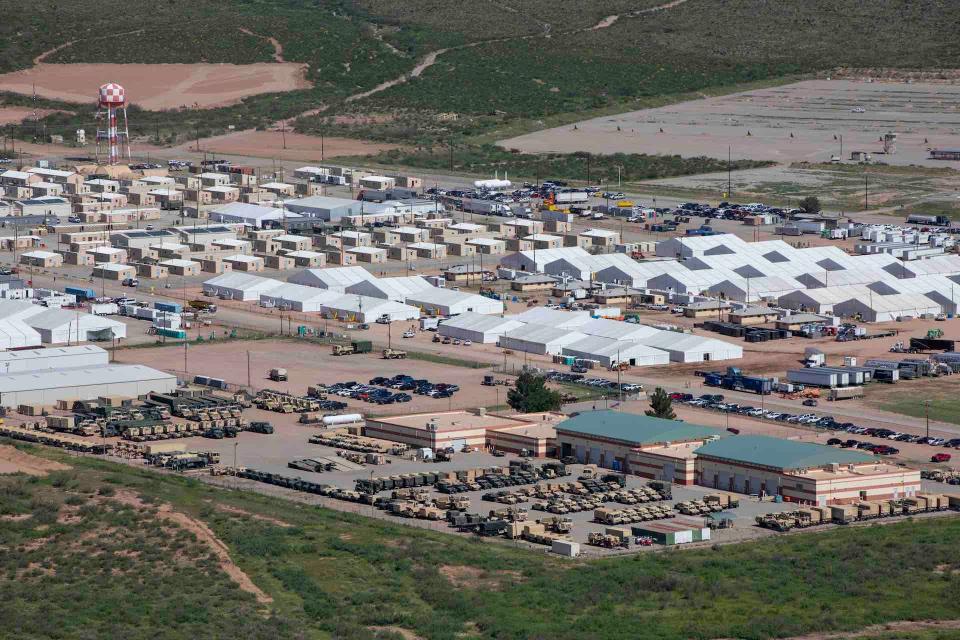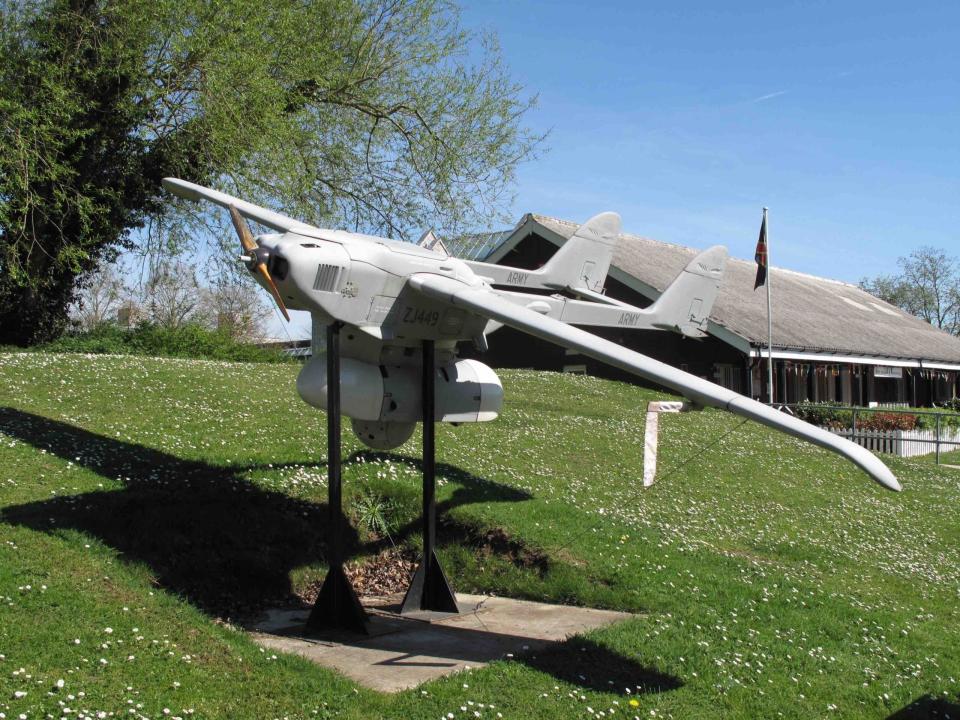Examining The Deployment Of The U.K.'s Troubled Watchkeeper Drones At Fort Bliss

Last year, the British Army established a detachment of its beleaguered Watchkeeper drones at the U.S. Army's Fort Bliss in New Mexico/Texas. Exercise Athena Eagle, as the detachment from the British Army's Watchkeeper Flying School has been called, began on September 22, 2022, and is designed to improve interoperability between U.K. and U.S. sensor platforms.
In total, four Watchkeeper drones are currently based at a small airfield inside Training Area 4D of Fort Bliss' Doña Ana Complex, New Mexico. Roughly 45 members of the 47th Regiment, Royal Artillery, have deployed to Fort Bliss to provide support to the Watchkeeper Flying School’s 24 personnel, including instructors and students. According to a British Army spokesperson, the Watchkeeper Flying School’s temporary deployment to the United States is “currently due to last until Dec[ember] 26” of 2023.

The Watchkeeper UAV fulfills the role of a "tactical unmanned aerial system," or TUAS for the British Army. The TUAS is a short-range option for airborne intelligence gathering at the brigade level.
The Gray Eagle UAS Complex at Fort Bliss — a pair of runways with a 50,000 square-foot hangar — was built in 2016 to support the new MQ-1C Gray Eagle UAVs being added to the 1st Armored Division’s Combat Aviation Brigade (CAB). The main 5,000-foot-long runway was designed specifically to support the Gray Eagles, while the smaller 1,000-foot-long runway was for the existing RQ-7 Shadows already in service with the 1AD CAB. This makes the Gray Eagle UAS Complex perfectly suited for Watchkeeper operations, with its similar operating requirements and mission scope to that of the RQ-7.

In October 2022, two of the detachment's Watchkeeper drones went to California to participate in Project Convergence 2022 at Fort Irwin. Just a month later, one of the airframes that participated in Project Convergence crashed while on a planned flight out of Fort Bliss.
At Project Convergence 22, Watchkeeper drones were used to learn how to better reduce complications with the "sensor-decider-effector-sustainer" chain, which integrated the U.K.'s sensor platforms with other participating nations' sensor platforms to provide a more complete picture of the battlefield. Three months later, the Twitter account for the British Army staff in the U.S. posted a photo showing three Watchkeeper airframes inside a hangar at the Grey Eagle UAS Complex at Fort Bliss, noting that this was a detachment of the 47th Regiment RA.

In his book, British Army Aviation in Action: From Kosovo to Libya, Tim Ripley writes that as part of Operation ENTIRETY in May 2010, the 47th Regiment RA was officially reorganized to focus on UAVs instead of operating them as a secondary responsibility. Prior to this, the 47th Regiment RA served a smaller role alongside the 32nd Regiment, Royal Artillery, using hand-launched UAVs such as the Lockheed Martin Desert Hawk and, at that point, leased Hermes 450s under Project Lydian to support operations on the ground.
The reorganization of the 47th Regiment RA paved the way for them to operate Watchkeeper when it was cleared for use by the British Ministry of Defense in 2014. In 2016, the 32nd Regiment RA was scaled down and many of its personnel were redistributed, with most of the personnel trained in UAVs transferred to the 47th Regiment RA.
Prior to the introduction of Watchkeeper drones, the first TUAS operated by the British Army was the GEC-Marconi Phoenix, which saw use in Kosovo between 1999 and 2001. The use of Phoenix as part of Operation Agricola, the U.K.'s contribution to the eventual deployment of land forces in Macedonia and Kosovo, showed that the Phoenix could operate as an intelligence asset as well as directing artillery fire.

However, the Phoenix had flaws. In 2003, when Phoenix was deployed to Iraq, it became apparent that it could not operate effectively in the Iraqi heat. Thales U.K. and Elbit's offering for the Watchkeeper program, a modified Hermes 450, was selected to replace the Phoenix in 2004, shortly before the Phoenix was retired in 2006.
Watchkeeper was not ready to fill this capability gap in Iraq, and so Thales U.K. was contracted to fulfill an urgent operational requirement for Hermes 450 drones. Known as Project Lydian, Thales U.K. provided eight H450 airframes which saw service in Iraq and Afghanistan. The Project Lydian drones racked up over 100,000 hours of flight time during their service with the Army. It took until 2010 for a Watchkeeper airframe to make its first flight, and after multiple setbacks and delays it took another four years for Watchkeeper to be declared fully operational.

Watchkeeper has spent much time outside of the U.K. for training, with deployments to Ascension Island (Exercise Aries Spider from 2016 to 2017) and Cyprus (Exercise Athena Rebus, starting in 2019) for the final phase of pilot flight training. This is at least in part because Watchkeepers could not deal with the poor British weather. A report from The Bureau of Investigative Journalism in 2015 noted that the British Army was worried about the effect of the English climate on the airframe. At least one Watchkeeper was lost due to poor weather. WK042 crashed in 2017 just off the coast of Wales due to precipitation affecting the ability of the aircraft to determine its airspeed. Thus, warmer and drier climates were required. Fort Bliss meets the criteria, with similar weather to other successful Watchkeeper training areas.
In a written report submitted to Parliament in March 2023, former Watchkeeper Capability Manager David Chaytor spoke at length on the overall failings of the Watchkeeper program. He noted the drone’s failure to meet 11 Key User Requirements, having met only one as of November 2018 when full operational capability (FOC) was declared. Chaytor indiacted that, “Despite FOC being delivered on paper in November 2018, 47 Regt Royal Artillery have never proven that they can deliver this capability. It is doubtful that they could deliver 15% of the capability defined in the FOC definition statement.”

As part of the initial requirement for Watchkeeper, the MOD expected the program to deliver up to 6,000 flight hours per year. Between the initial FOC declaration in November 2018 and November 2022, the total hours flown was only 1,191, far short of the expected 18,000 hours. Chaytor also indicated that the 47th Regiment RA has never tested the 16-hour endurance capability in practice, due to, among other things, RAF Akrotiri’s limitations on Watchkeeper flight time: the drones are limited to a 6-hour flying window, Monday through Thursday and only at night.
Chaytor further noted that while Watchkeeper has an estimated operating cost of £8,000 per flight hour, the actual cost per flight hour is over £88,400 due to the low flying rate. He estimates that on top of the existing £1.173 billion already spent, as of October 2021, on a system that does not work, an additional £1.149 billion will be required to bring it up to the standards set in the original 2007 contract and support it until its planned end of life in 2042.
Moreover, at least eight Watchkeepers out of a total fleet of 54 are known to have crashed, several of which were due to weather or system failures. The causes of these crashes ranged from unexpected precipitation to human error.
It should be noted that the Royal Air Force has looked to other uncrewed platforms of late, notably working with General Atomics in California to develop Protector, a variant of the MQ-9 Reaper. The RAF accepted the first airframe in October 2022, just before the British Army mentioned that their Watchkeepers were participating in Project Convergence 22 100 miles away. Protector will serve an armed medium altitude, long endurance role as a replacement for the leased MQ-9s currently in use by the RAF. It is a customized sibling of the MQ-9B SkyGuardian, with the capability to be equipped with offensive weapons and a wide variety of sensors, communications systems, and electronic warfare pods. The MQ-9 offers significantly longer endurance, higher altitude, and more sensors and weapons capacity than the Watchkeeper, fulfilling a much broader role as required by the RAF.

The expansion of Watchkeeper training operations in the U.S. may allow for more frequent joint drone operations practice, and intelligence sharing between the U.S. and the U.K. The proximity of the British and U.S. Army drones to each other could allow large exercises with the purpose of developing new technologies and techniques such as Project Convergence and the Experimental Demonstration Gateway Event, commonly referred to as EDGE, to experiment with international UAV collaboration on a larger scale. The ability for British UAV pilots to learn Watchkeeper and also gain an understanding of U.S. Army drone infrastructure is something not found at other Watchkeeper training sites.
With that said, however, it remains to be seen if the RAF can finally overcome the persistent problems it has experienced with Watchkeeper drones to date and turn the program into anything remotely resembling a success.
Contact the editors: thomas@thedrive.com, oliver@thewarzone.com

